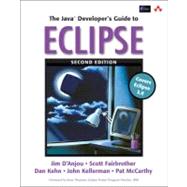
| Foreword | |
| Preface | |
| Origin of the Book | |
| Goals | |
| Intended Audience and Prerequisites | |
| How the Book Is Organized | |
| Coding Conventions | |
| CD-ROM | |
| Where to Find Further Information | |
| Guide to Reading This Book | |
| Acknowledgments | |
| About the Authors | |
| Read Me First | |
| Eclipse as a Host for Application Development Tools | |
| Beyond Tools: Eclipse as a Host for Client Applications | |
| What Is Eclipse? | |
| Getting and Installing Eclipse | |
| Chapter Summary | |
| References | |
| Using Eclipse | |
| Getting Started with Eclipse | |
| Your First Steps | |
| Basic Eclipse Use | |
| Resource Management | |
| Customizing Eclipse | |
| Exercise Summary | |
| Chapter Summary | |
| Reference | |
| Using Java Development Tools | |
| Getting Started with JDT | |
| Writing Java Code | |
| Working with Java Elements | |
| Tuning the Performance of the JDT | |
| More on the JDT Views and Preferences | |
| Exercise Summary | |
| Chapter Summary | |
| Reference | |
| Running and Debugging Java | |
| Running Java Code | |
| Debugging | |
| Remote Debugging | |
| Exercise Summary | |
| Chapter Summary | |
| Reference | |
| Teaming Up with Eclipse | |
| Eclipse Support for CVS | |
| General Team Support by Eclipse | |
| An Overview of CVS for the Novice | |
| The CVS User Interface in Eclipse | |
| Special Situations and How to Handle Them | |
| Additional Features | |
| Exercise Summary | |
| Chapter Summary | |
| References | |
| Managing Your Eclipse Environment | |
| An Overview of Your Eclipse Installation | |
| Understanding the Runtime Configuration | |
| Coordinating Preferences | |
| Understanding Configuration Management Fundamentals | |
| Interacting with the Update Manager | |
| Managing Your Configuration | |
| Chapter Summary | |
| Reference | |
| Fundamentals of Extending Eclipse | |
| Extending Eclipse for Fun and Profit | |
| Excited About Extending Eclipse? You Should Be! | |
| An Easy and Practical Example | |
| A Brief Tour of "Hello, World" | |
| Asking the Right Question Is More Important Than Knowing the Answer | |
| Where to Go from Here? | |
| Overview of the Eclipse Architecture | |
| That Was Then, This Is Now | |
| Architectural Top Priorities: Extensibility and Integration | |
| Eclipse the IDE Platform and Rich Client Application | |
| The Eclipse Platform Runtime | |
| User Interface Frameworks | |
| Workbench Frameworks | |
| Chapter Summary | |
| References | |
| Getting Started: Plug-in Development | |
| Getting Started with Plug-ins | |
| Getting Started with Extensions and Extension Points | |
| Basic Steps of Implementing a Plug-in | |
| Using the Plug-in Development Environment | |
| Exercise Summary | |
| Chapter Summary | |
| References | |
| Creating Applications Using the Rich Client Platform | |
| Reasons Applications Are Being Built on the RCP | |
| Eclipse Architecture, Revisited | |
| Opportunities for Reuse of Eclipse | |
| Implementing Your Own Workbench | |
| Exercise Summary | |
| Chapter Summary | |
| References | |
| Creating Extension Points: How Others Can Extend Your Plug-ins | |
| Relationship Between Extension Points and Extensions | |
| Viewing the Official List of Enabled Plug-ins, Extensions, and Extension Points | |
| How to Define Extension Points | |
| Handling Dynamic Plug-ins | |
| How to Enable the Schema-Based New Extension Wizard | |
| Example Summary | |
| Chapter Summary | |
| References | |
| Advanced Plug-in Development | |
| Migrating Your Plug-ins from E | |
| Table of Contents provided by Publisher. All Rights Reserved. |
The New copy of this book will include any supplemental materials advertised. Please check the title of the book to determine if it should include any access cards, study guides, lab manuals, CDs, etc.
The Used, Rental and eBook copies of this book are not guaranteed to include any supplemental materials. Typically, only the book itself is included. This is true even if the title states it includes any access cards, study guides, lab manuals, CDs, etc.